
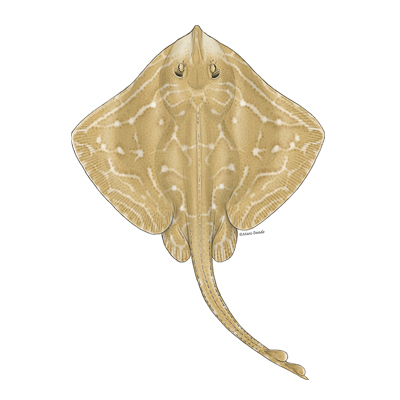
Small-eyed ray is a small species of ray which is a member of the skate family, like all skates it lays eggs and has a spiny tail that lacks a sting. It is commonly marketed as skate wings. This species is commonly found around the north coast of Cornwall and is abundant in the Bristol channel. It is easily identified by its colour; a sandy background with pale lines running parallel with the front edges of the wings.
Stocks of all skates and rays are poorly studied in our area, however we have some detailed studies carried out in area 7f and g (off Cornwall's north coast) that show that here the stocks are healthy and fishing pressure is within sustainable levels. Unfortunately we dont have the same level of information on this species off the south coast so ratings from here are not as good. If you choose to buy skate be aware that when they have been skinned it is impossible to tell which species you are buying so please be careful and ask to see the ray before it is skinned to ensure you are not buying an unsustainable ray. It is not recommended that you buy skate wings that are smaller than 22cm. Management of this species is poor (a multi species quota for rays) and it is hard for trawlers and netters to avoid accidental by-catch off this species.
In 2021 34 tonnes of small-eyed ray were landed to Cornish ports with a value of £47k (MMO data)
Updated July 2023
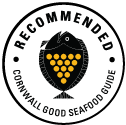
Bristol Channel, Celtic sea north 7 f and g
A large trawl held open by paravane trawl doors, the open net is then pulled along in contact with the seabed.
Learn moreBristol Channel, Celtic sea north 7 f and g
Caught using heavy beam trawl nets that are dragged over the seabed.
Learn moreBristol Channel, Celtic sea north 7 f and g
Caught using monofilament nets set on the seabed
Learn moreSouth coast Cornwall (7d, 7e)
A large trawl held open by paravane trawl doors, the open net is then pulled along in contact with the seabed.
Learn moreSouth coast Cornwall (7d, 7e)
Caught using monofilament nets set on the seabed
Learn moreSouth coast Cornwall (7d, 7e)
Caught using heavy beam trawl nets that are dragged over the seabed.
Learn moreCornwall Good Seafood Guide rates fish on sustainability using a scale of 1 to 5.
1, 2 and 3 are recommended, Fish to avoid are rated 5.
We use the system devised by the Marine Conservation Society (MCS) so our scores are comparable with the scores produced by MCS for the UK and fisheries from all around the world. For more information on scoring click here.
Small-eyed rays belong to the Rajidae family which includes skates and rays. Small-eyed rays are a small to medium sized inshore and coastal species, attaining a maximum length of 80 to 90cm and weight of 8kg. All skates are slow growing and produce few eggs per year compared to commercially targeted fin fish. Males and females mature from 44 to 58cm in length. Age at maturity and maximum age is unknown. Small-eyed rays produce between 54 and 61 eggs per year. They have a high level of biological vulnerability 62/100 Cheung et all 2005. (www.fishbase.org)
Lastest advice from ICES showes that in area 7f and 7g (off Cornwalls north Coast) this species is now doing well with biomass above MSY and fishing pressure below MSY. This is very good news.
Stocks of small eyed ray off the South Cornish Coast (areas 7e and d) cannot be assessed due to insuficcient data.
The International Conservation Union (IUCN) have rated the species as "Near Threatened" in the Northeast Atlantic.

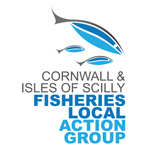
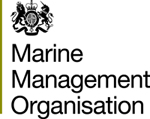
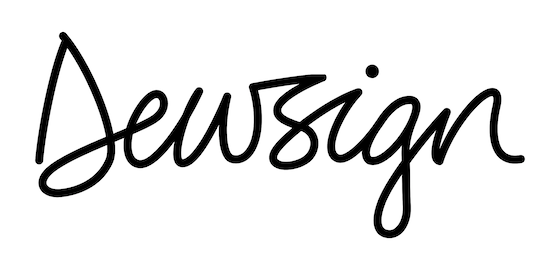


Cornwall Good Seafood Guide is underpinned by the Marine Conservation Society (MCS) Good Fish Guide. The first UK consumer guide to sustainable seafood. For more information visit www.fishonline.org
Cornwall Good Seafood Guide is here to help us all make sustainable seafood choices. Choices that will help us keep the oceans healthy and Cornish fishers' futures safe. This website is funded by Cornwall Wildlife Trust. If you would like to make a meaningful difference to the health of our oceans, please consider making a donation to the Cornwall Wildlife Trust Ocean Emergency fund. Your donation will help safeguard these remarkable environments, ensuring that they continue to thrive for generations to come. Together, we can be stewards of the seas and champions for a healthier, more sustainable future.